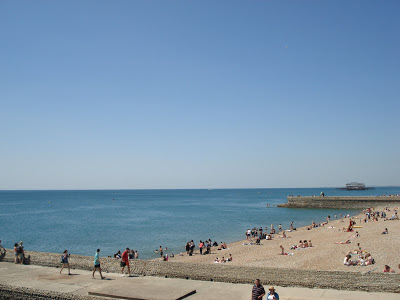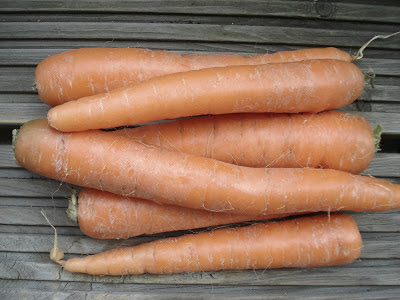On the Verge
It's hot. So hot that my sweetheart and I escaped to the coast for the day. I'm not usually a beach person, the salty air and sea water do not hold much sway over my heart. But it is so hot (for London) that it was a relief to get blasted by the sea breeze. Even if I dozed off while reading, and ended up with a sunburn.
It's at times like these that I truly crave Japanese foods. Not because Japanese cuisine is devoid of cooking (it isn't.) Neither is it because it is simple (it isn't necessarily so.) Nor is it because I feel a strong attachment to my Japanese heritage (I never really felt particularly Japanese, and my two year stay there put the nail in that coffin.) No, it's because the Japanese are dab hands at coming up with dishes that'll tempt even the most heat-stressed appetite. And my mum -who likes hot and muggy weather as much as I do- would often whip up these summer standards at the first sign of mercury rising. Like hiyashi chuuka. It's another cold noodle dish, and even if its name translates to "chilled Chinese noodles", I don't think it actually originates from China. In fact, the only thing remotely Chinese about Hiyashi chuuka are the ramen or egg noodles used as a base for what is essentially a noodle salad.
In truth though, the noodles are inconsequential. The main feature of this dish is the topping. Purists will claim that only a specific list of toppings are allowed to top the chilled egg noodles, but I am not a purist. So here is a step by step account to building your own chilled noodle salad. Start with a deep dish, or a wide bowl. Mound a portion of cooked and chilled noodles (follow the above link for instructions on chilling noodles.) One portion amounts to: one nest of egg noodles; one packet of fresh or dried ramen; a single bundle of soba (buckwheat) or somen (thin, salty and wheat-based) noodles; or one layer of rice noodles. While I am not sure that udon (thick wheat noodles) would suit this salad, pasta is, unconventionally, nice. Chill the plate while you prepare the toppings.
The following are mere suggestions, as anything goes. Finely chop two leaves of napa or Chinese cabbage. Sliver some red pepper. Julienne some cucumber, avoiding the watery seeds. Shred an omelette, if you are in the mood for eggs. Radish are a nice addition, and, unless you actually live in Japan, will be easier to find than the more authentic daikon. Cook some mushrooms in a simmering pot of water (I usually just use the cooking water from the noodles.) Shitake mushrooms are fairly easy to find in supermarkets, but enoki are also increasingly so.
Enoki are thin, long and white mushrooms. They usually come in bunches with gnarly roots: these simply need to be cut off before cooking. Enoki are most often used soups, and once cooked, they take on a marvellous texture that is best described by the Japanese word korikori. I've tried to explain this word in English before and have been stumped. The closest thing I can think of is a bit unappetising: korikori is the texture of chewing on cartilage. Enoki, being mushrooms, are not as crunchy as actual cartilage, but they have the same chewy-crunchy-slippery thing going for them. Maybe it's an Asian thing, but it is a rather pleasant texture when contrasted with soft noodles.
Once you've got all the toppings prepared, they get piled up in orderly wedges atop the chilled noodles, just as if you were drawing a pie chart. Sprinkle some slivered green onions for garnish. And while your plate is chilling in the icebox, prepare the dressing. I do believe that the actual dressing for hiyashi chuuka is tsuyu-based (see above link), but the following is a simplefied version:
Express Hiyashi Dressing
For each person
2Tbs rice wine vinegar
2Tbs soy sauce
1Tbs sugar
Stir all the ingredients together until the sugar is dissolved.
Drizzle over the topped noodles, and chow down!
If you feel the need for a protein besides eggs, you can go traditional, and add some shredded ham, but prawns (North Atlantic shrimps may still be available...), crab or even crab sticks also fill in the gap nicely. When eating hiyashi chuuka, it is really important to dig down to the bottom of the bowl to soak up all the dressing.
Bon app'!
In truth though, the noodles are inconsequential. The main feature of this dish is the topping. Purists will claim that only a specific list of toppings are allowed to top the chilled egg noodles, but I am not a purist. So here is a step by step account to building your own chilled noodle salad. Start with a deep dish, or a wide bowl. Mound a portion of cooked and chilled noodles (follow the above link for instructions on chilling noodles.) One portion amounts to: one nest of egg noodles; one packet of fresh or dried ramen; a single bundle of soba (buckwheat) or somen (thin, salty and wheat-based) noodles; or one layer of rice noodles. While I am not sure that udon (thick wheat noodles) would suit this salad, pasta is, unconventionally, nice. Chill the plate while you prepare the toppings.
The following are mere suggestions, as anything goes. Finely chop two leaves of napa or Chinese cabbage. Sliver some red pepper. Julienne some cucumber, avoiding the watery seeds. Shred an omelette, if you are in the mood for eggs. Radish are a nice addition, and, unless you actually live in Japan, will be easier to find than the more authentic daikon. Cook some mushrooms in a simmering pot of water (I usually just use the cooking water from the noodles.) Shitake mushrooms are fairly easy to find in supermarkets, but enoki are also increasingly so.
Enoki are thin, long and white mushrooms. They usually come in bunches with gnarly roots: these simply need to be cut off before cooking. Enoki are most often used soups, and once cooked, they take on a marvellous texture that is best described by the Japanese word korikori. I've tried to explain this word in English before and have been stumped. The closest thing I can think of is a bit unappetising: korikori is the texture of chewing on cartilage. Enoki, being mushrooms, are not as crunchy as actual cartilage, but they have the same chewy-crunchy-slippery thing going for them. Maybe it's an Asian thing, but it is a rather pleasant texture when contrasted with soft noodles.
Once you've got all the toppings prepared, they get piled up in orderly wedges atop the chilled noodles, just as if you were drawing a pie chart. Sprinkle some slivered green onions for garnish. And while your plate is chilling in the icebox, prepare the dressing. I do believe that the actual dressing for hiyashi chuuka is tsuyu-based (see above link), but the following is a simplefied version:
Express Hiyashi Dressing
For each person
2Tbs rice wine vinegar
2Tbs soy sauce
1Tbs sugar
Stir all the ingredients together until the sugar is dissolved.
Drizzle over the topped noodles, and chow down!
If you feel the need for a protein besides eggs, you can go traditional, and add some shredded ham, but prawns (North Atlantic shrimps may still be available...), crab or even crab sticks also fill in the gap nicely. When eating hiyashi chuuka, it is really important to dig down to the bottom of the bowl to soak up all the dressing.
Bon app'!








Comments
Post a Comment